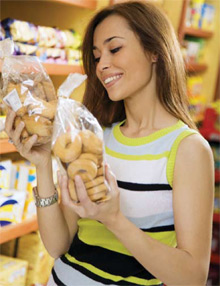What are Nutrition Labels or Nutrition Information Panels (Nip)?
They are panels found at the back or the side of pre-packaged foods that provide detailed information on the nutritional content of the product.
Why are the Labels Important?
- Educate us on the nutritional contents of the food we intend to purchase.
- Guide us to make appropriate food choices, taking into consideration our energy and nutrient needs.
- Enable us to make comparisons between similar products of different brands.
What should You Look for in a Label?
| NUTRITION INFORMATION | ||
|---|---|---|
| Serving size: 5 pieces (20g) Servings per package: 5 | ||
| Nutrients | Per 100g | Per serving (20g) |
| Energy, kcal | 525 | 105 |
| Carbohydrate, g | 56.2 | 11.2 |
| Protein, g | 8.0 | 1.6 |
| Fat, g | 29.8 | 6 |
- Serving size. This is the amount usually consumed at one time. In this example, the suggested serving size is 5 pieces or 20 gram.
- Serving per package. This indicates the number of servings available in one packet of the food product. In this example, each packet contains 5 servings of the food.
- Nutrient listing. This list shows the energy, protein, carbohydrate and fat declared in the NIP. Vitamins, minerals and fibre may also be listed. Choose foods with higher protein as well as those rich in calcium, iron and vitamins for your child. Reduce intake of foods that are high in fats and sodium contents.
- Amount of nutrients. This column lists the amount of energy and nutrients contained in every 100g or 100ml of the food product. If you wish to compare nutritional values of one product with another similar one, you must make the comparison based on 100g or 100ml.
- Amounts of nutrients per serving. The figures stated in this column shows the amount of energy and nutrients your child receives if he consumes one serving of this food. If he consumes two or three servings, the amount of nutrients and energy consumed multiplies accordingly.
Remember to make choices based on the overall nutrient content, and not just on one or two nutrients declared on the NIP. It is also important to know how much your child actually needs to help you make the best and healthiest choices for your child. Get into the habit of reading nutrition labels whenever you go grocery shopping; the more practice you get, the better you become in using them as a tool to plan a well-balanced, healthy diet for your whole family!






Comments